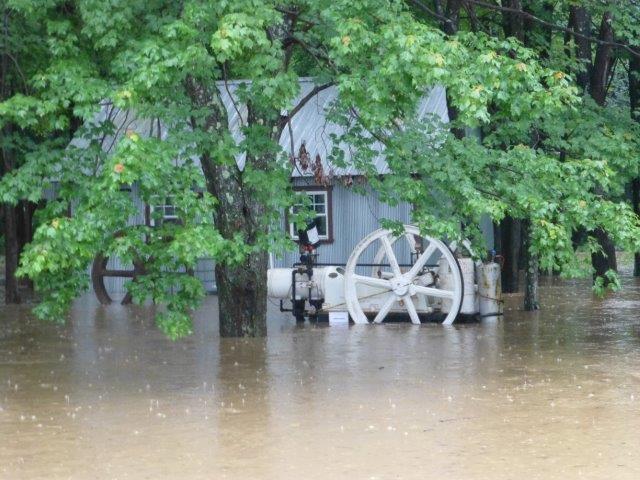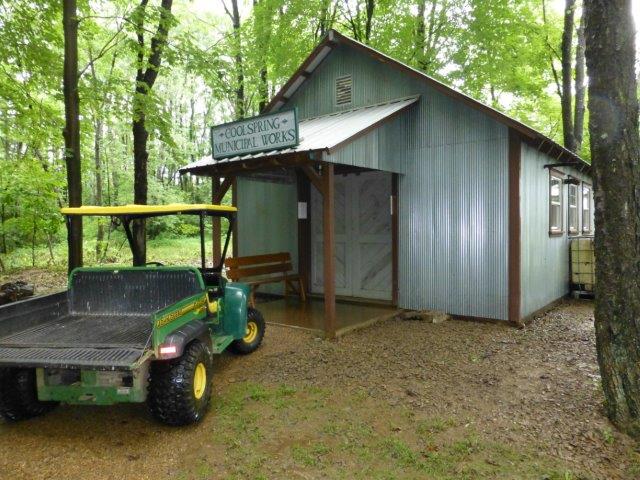
September 2013
Flood
By Paul Harvey
I was to learn later that much more rain had fallen in
our watershed to the east of Coolspring. Several bridges were washed
out and small drainage ditches became raging torrents eating the
pavement away and closing roads. The state equipped their trucks with
snow plows to clear the debris on the roads. The city of
Historically, the museum did suffer a very major flood in July, 1996. At that time we had 2 to 3 feet of water in all the main buildings doing much damage. The last time Coolspring registered such a flood was 1936 and all the folks talked about it for years. But the 1996 flood was higher and considered to be a 100 year disaster. Yet just 17 years later a flood occurred that crested only 2 feet lower than the 1996 flood.
Photo 1 shows the general view of the
museum from the restroom area. This was taken about
Photo 3 shows our windmill surviving but with water surrounding its legs. At least it did not have to work to pump any water this day! But with the windmill surrounded, the food court was now partially covered with brown muddy water that floated in sticks and all kinds of debris.
Looking at the other side of the museum grounds,
Photo 4 shows the exhaust pit for
As the rain gradually tapered off, the water crested
about
Photo 8 is a shot of the driveway between
the
Another photo shot in the wooded area shows the water up to the crankshaft of the McIntire and Willetts engine located near the other small structures. This is shown in Photo 9 with the Pattin Brothers Power building in the background. This water was raging through and left much flood debris of all kinds. Many days were taken to get most of it cleared up and hauled away but there are still many places that the evidence of the flood can be seen. Indeed, there will be evidence of this flood for years to come.
By
As you are reading this most all the damage has been either cleaned up or repaired. But looking closely one can see the evidence of flood debris sticking in places along the creek bank and various trees. It will take the rest of the year for all to return to normal. It is our hope that this will not happen again for 100 years.
Is seems that the year has gone so quickly, but the museum season is drawing to a close. We will be open for the September weekend on September 21 and 22, 2013 and our big Fall Expo and Swap Meet will be October 17, 18 and 19, 2013. This will be a big show and will be our last event for the year. Personal tours and visitation can be scheduled by prior arrangement after this date. For more information please call 814-849 6883. See you then!

Photo 1: A general view of the flooded museum grounds
Note the tree line in the distance. It's actually the west border of the museum's exhibitor field! When the Little Sandy Creek overflowed it flooded a large portion of the musuem property.

Photo 2: The museum signboard and Pederson Pavilion

Photo 3: The museum windmill

Photo 4: Windy City exhaust pit
The tree line in this photo is the south border of the musuem exhibitor field. The Little Sandy Creek normally flows past the show grounds just beyond the first trees.

Photo 5: The Coolspring Municipal Works building

Photo 6: The Harvey Expo building

Photo 7: A view of the structure housing the creek pumps

Photo 8: The driveway at the Susong building

Photo 9: The Pattin Brothers Power building

Photo 10: Debris left in the Food Court

Photo 11: Flood damage at the Municipal Works